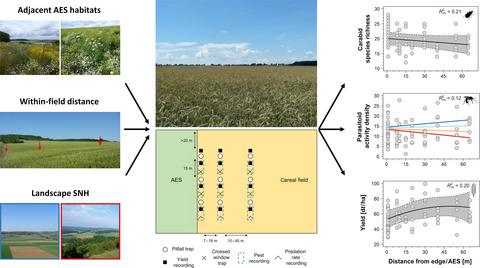当前位置:
X-MOL 学术
›
J. Appl. Ecol.
›
论文详情
Our official English website, www.x-mol.net, welcomes your feedback! (Note: you will need to create a separate account there.)
Pest control potential of adjacent agri‐environment schemes varies with crop type and is shaped by landscape context and within‐field position
Journal of Applied Ecology ( IF 5.7 ) Pub Date : 2020-05-20 , DOI: 10.1111/1365-2664.13653 Fabian A. Boetzl 1 , Maren Schuele 1 , Jochen Krauss 1 , Ingolf Steffan‐Dewenter 1
中文翻译:

邻近农业环境计划的害虫控制潜力因作物类型而异,并受景观环境和田间位置的影响
更新日期:2020-05-20
Journal of Applied Ecology ( IF 5.7 ) Pub Date : 2020-05-20 , DOI: 10.1111/1365-2664.13653 Fabian A. Boetzl 1 , Maren Schuele 1 , Jochen Krauss 1 , Ingolf Steffan‐Dewenter 1
Affiliation

|
- Increasing natural pest control in agricultural fields is an important aim of ecological intensification. Combined effects of landscape context and local placement of agri‐environmental schemes (AES) on natural pest control and within‐field distance functions of natural pest control agents have rarely been addressed but might affect the distribution of biocontrol providers. Importantly, it is currently unknown whether ecosystem services provided by adjacent AES are consistent for different crop types during crop rotation.
- In this study, we assessed whether crop rotation from oilseed rape to cereals altered within‐field distance functions of ground‐dwelling predators from adjacent agri‐environmental fields along a gradient in landscape context. Additionally, we recorded crop pests, predation rates, parasitoids as well as crop yields on a total of 30 study sites.
- Distance functions varied between trophic levels: Carabid richness decreased while densities of carabid beetles, staphylinid beetles as well as crop yields increased towards the field centres. Distance functions of parasitoids and pests were modulated by the amount of semi‐natural habitat in the surrounding landscape, while the effects of adjacent AES were limited.
- Distance decay functions found for ground‐dwelling predators in oilseed rape in the previous year were not always present in cereals. Increasing distance to the field edge also increased effects of crop rotation on carabid beetle assemblages, indicating a source habitat function of field edges.
- Synthesis and applications. Distance functions of natural pest control are not universal and the effects of agri‐environmental schemes (AES) in different adjacent crops during crop rotation vary and depend on ecological contrasts. A network of semi‐natural habitats and spatially optimized AES habitats can benefit pest control in agricultural landscapes, but constraints as a result of crop type need to be addressed by annually targeted, spatially shifting agri‐environment schemes for different crops.
中文翻译:

邻近农业环境计划的害虫控制潜力因作物类型而异,并受景观环境和田间位置的影响
- 加强农田自然害虫防治是生态集约化的重要目标。景观环境和农业环境方案在当地的放置对自然害虫控制以及自然害虫控制剂的田间距离功能的综合影响很少得到解决,但可能会影响生物防治提供者的分布。重要的是,目前尚不清楚相邻AES提供的生态系统服务在轮作期间是否适用于不同作物类型。
- 在这项研究中,我们评估了从油菜到谷物的轮作是否沿地貌梯度改变了邻近农业环境田间地上天敌的田间距离函数。此外,我们在总共30个研究地点记录了农作物的害虫,捕食率,寄生虫以及农作物的产量。
- 距离函数在营养级别之间有所不同:在田间中心,甲壳类动物的丰富度降低了,而甲壳类,甲类,甲壳类和植物的密度增加了。寄生虫和害虫的距离函数受周围景观中半自然生境的数量调节,而相邻AES的影响受到限制。
- 上一年在油菜中发现的地面掠食者的距离衰减函数并不总是存在于谷物中。到田间边缘的距离增加,也增加了农作物轮作对甲壳虫甲虫组合的影响,表明田间边缘的源生境功能。
- 综合与应用。天然害虫控制的距离函数不是普遍的,并且在轮作期间不同相邻农作物的农业环境计划(AES)的影响各不相同,并取决于生态对比。半自然生境和空间优化的AES生境网络可以使农业景观中的虫害控制受益,但是由于作物类型的限制,必须通过针对不同作物的年度针对性,空间转移的农业环境计划来解决。


























 京公网安备 11010802027423号
京公网安备 11010802027423号